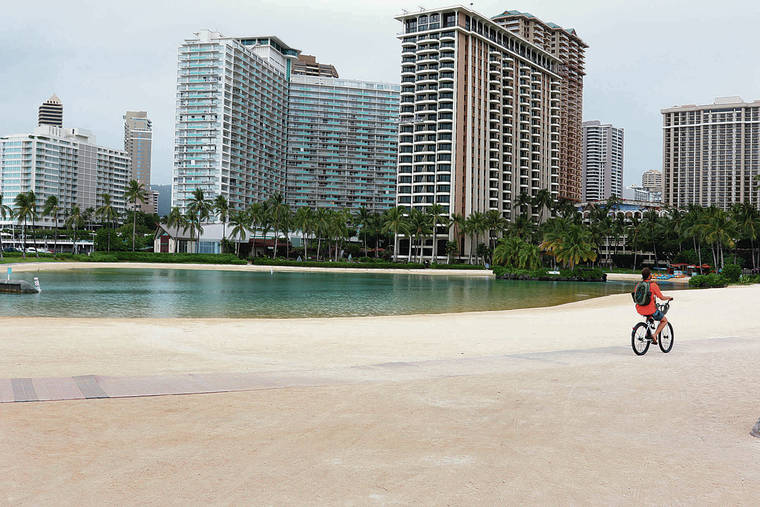Hawaii tourism is on life support as visitor arrivals plunge 99% in May

ASSOCIATED PRESS
The COVID-19 pandemic has been brutal to the tourism-dependent economy of Hawaii. A man rides his bike on an empty Waikiki Beach in late April.
Visitor arrivals to the Hawaiian Islands fell by a dramatic 98.9% in May compared with a year ago due to the COVID-19 pandemic Opens in a new tab, according to preliminary statistics from the Hawaii Tourism Authority.
The HTA released the statistics Monday, indicating dramatic declines in virtually all travel markets — from the mainland as well as Japan, Canada and other international markets, including Australia, Asia and Europe.
A total of 9,116 visitors flew to Hawaii in May, compared with 841,376 total visitors, which included air and cruise ships, during the same month a year ago.
Most, or 4,357, came from the U.S. West’s Pacific region, which was a mere 1.6% of the 292,106 visitors a year ago. Another 1,443 came from the Mountain region, also 1.6% of the 88,487 visitors who arrived a year ago.
A scant 25 visitors arrived from Europe, 21 each from New Zealand and Korea, 20 from Canada, 16 from China, 14 from Japan, 11 from Latin America, seven from Taiwan and two from Australia.
Visitor arrivals have plunged since Gov. David Ige on March 26 ordered all travelers to Hawaii — and in April, all interisland travelers — to undergo a mandatory, 14-day quarantine to help stop the spread of the new coronavirus.
Don't miss out on what's happening!
Stay in touch with breaking news, as it happens, conveniently in your email inbox. It's FREE!
While it appeared to help Hawaii achieve the lowest infection rate of any U.S. state, visitor arrivals have dropped nearly 100% in April and May, and the mandatory quarantine has crippled the state’s economy, which is heavily reliant on tourism, resulting in the closure of hotels and businesses tied to the visitor market.
Some economists have warned of the dire consequences of extending the closure much longer.
The mandatory quarantine for interisland travelers was lifted June 16 as part of a phased approach to reopening the state’s economy.
Out-of-state travel is expected to pick up in August, under a new testing protocol Ige announced last week Opens in a new tab. Starting Aug. 1, passengers with approved negative COVID-19 tests taken within 72 hours of their trip to Hawaii can bypass the 14-day quarantine.
Hotels throughout the state are gearing up for the restart of out-of-state tourism Opens in a new tab, with hopes of some recovery. Ige, however, is expected to extend the out-of-state quarantine beyond July 31.
Tim Brown Opens in a new tab, a senior fellow in infectious disease at the East-West Center, co-authored a recent study Opens in a new tabon the prevention of travel-related reintroduction of COVID-19 to Hawaii that presented a strategy for travelers of multiple points of screening, particularly prior to boarding a plane for Hawaii.
The University of Hawaii Economic Research Organization study points out that screening air passengers for high temperatures prior to leaving removes about one-third of infectious passengers from flights to Hawaii. Adding a test for COVID-19 removes 80% to 90% of infectious passengers from flights to Hawaii.
If tourism resumes, with 6,000 visitors arriving daily screened only for temperature and symptoms, the authors estimated it would lead to 750 additional active infections in the community per month, overwhelming the state’s health care system. With the test, this would be reduced to about 150.
Air passengers should be given the opportunity to install an app, the study said, notifying them if they have been in close contact with an infected person while in Hawaii.
Brown, however, is concerned about recent double-digit increases in local coronavirus cases — an average of about 13 new infections a day in the past two weeks, indicating it is not under control.
On Sunday, Hawaii health officials reported 27 new cases Opens in a new tab, including a cluster of 17 associated with attending a funeral. Recent clusters are also associated with low-income housing, a nursing home and a pastor in Waipahu.
In addition to more urgent public messaging on wearing face masks, physical distancing and not congregating in large groups, Brown said there needs to be more aggressive testing, including individuals who are asymptomatic and those at greatest risk, along with prompt contact tracing.
This “new normal” incorporating these safety measures needs to be driven home, he said.
The next few weeks will be telling, he said, and if numbers continue to climb, he would seriously reconsider whether Hawaii is ready to reopen to visitors again.
“If we reopen to tourists without the local transmission under control, if we open up without enough solid contact tracing and testing in place, we will have to go through a shutdown again,” Brown said. “If we’re going to do this, we’re going to have to do it right. We can’t afford to make mistakes.”
VISITOR ARRIVALS
Other highlights from HTA’s May report:
>> Most of the visitors were from the U.S. West (5,842), which was down 98.5% from a year ago, and U.S. East (2,647), which was down 98.7% from a year ago.
>> The 14 visitors from Japan in May were just .01% of the 113,218 from a year ago. Year-to-date, arrivals from Japan declined 51.6% to 294,255 visitors.
>> Twenty-five visitors arrived from Europe compared with 10,255 visitors a year ago. Through the first five months of 2020, arrivals decreased 55.7% to 20,444 visitors.
>> A total of 97,753 trans-Pacific air seats serviced the Hawaiian Islands in May, down 91.3% from a year ago. There were no direct flights or scheduled seats from the U.S. East, Japan, Canada, Oceania or “Other Asia,” and few scheduled seats from the U.S. West.
>> For all major isles, total visitor days fell 95% or more compared with a year ago.



